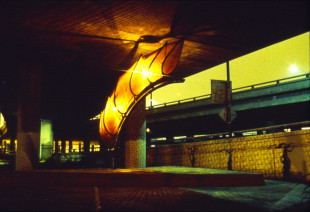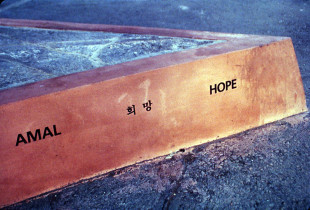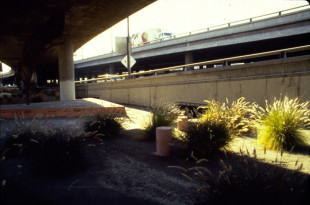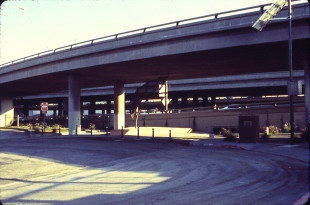- 01
- 02
- 03
- 04
- 05
- 06
- 07
The Garden of Conversion
Image list
- Hope Street Terminus: The Garden of Conversion (1996) – light sculpture and engraved concrete bench, night; steel, halogen lights, engraved colored concrete and asphalt mosaic bench; light sculpture
19’ x 5’ x 3’ - Hope Street Terminus: The Garden of Conversion (1996) – detail of light sculpture, night; steel and halogen lamps; light sculpture 19’ x 5’ x 3’
- Hope Street Terminus: The Garden of Conversion (1996) – light sculpture and engraved concrete bench, night; steel, halogen lamps, engraved colored concrete and asphalt mosaic bench; light sculpture
19’ x 5’ x 3’ - Hope Street Terminus: The Garden of Conversion (1996) – detail of bench and garden; engraved colored concrete and drought tolerant planting
- Hope Street Terminus: The Garden of Conversion (1996) – detail of bench; engraved colored concrete
- Hope Street Terminus: The Garden of Conversion (1996) – detail of installation; light sculpture, bench, stools, and garden; steel, halogen lamps, engraved colored concrete, drought tolerant plants; overall site approx.:
H-25’/W-50’/L- 100’ - Hope Street Terminus: The Garden of Conversion (1996) – detail of installation; light sculpture, bench, stools, garden, and solar photovoltaic system; steel, halogen lamps, engraved colored concrete, drought tolerant plants, solar panel and battery box; overall site approx.: H-25’/W-50’/L- 100’
Info
Artist Team: Blue McRight, Lead artist; and
Warren Wagner, architect
Project Title: Hope Street Terminus: The Garden of Conversion
Date Completed: 1996
Commissioned by: City of Los Angeles Community Redevelopment Agency
Project Location: Hope Street Terminus at 17th St., Los AngelesHope Street Terminus: The Garden of Conversion is a site-specific environmental work of public art that transformed a blighted area of Caltrans property underneath the 10 Freeway in downtown Los Angeles into open space for the community.The project incorporates the freeway structure as part of the artwork with a steel lantern sculpture, which, at night, uses the underside of the freeway deck, and adjacent areas as surfaces for projected patterns of light and shadow. The lantern is illuminated by solar electricity, generated during the day via photovoltaic panels mounted at the entrance to the site.
Warren Wagner, architect
Project Title: Hope Street Terminus: The Garden of Conversion
Date Completed: 1996
Commissioned by: City of Los Angeles Community Redevelopment Agency
Project Location: Hope Street Terminus at 17th St., Los AngelesHope Street Terminus: The Garden of Conversion is a site-specific environmental work of public art that transformed a blighted area of Caltrans property underneath the 10 Freeway in downtown Los Angeles into open space for the community.The project incorporates the freeway structure as part of the artwork with a steel lantern sculpture, which, at night, uses the underside of the freeway deck, and adjacent areas as surfaces for projected patterns of light and shadow. The lantern is illuminated by solar electricity, generated during the day via photovoltaic panels mounted at the entrance to the site.
The lantern’s base is a large concrete bench which channels storm water and functions as seating for the site, its mosaic surface created from recycling actual Hope Street asphalt. Inspired by place name as metaphor, inscribed onto the sides of the bench is the work HOPE is 48 languages.
Groups of drought tolerant plantings complete the artwork.






